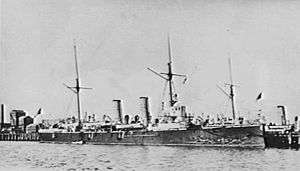HMS Mildura
HMS Mildura was an Pearl-class cruiser built for the Royal Navy in the late 1880s. Originally named HMS Pelorus, she was renamed after an Australian town in April 1890.[2] Per the Imperial Defense Act of 1887, she served primarily in Australian waters.
 HMS Mildura at Port Melbourne, May 1901 | |
| History | |
|---|---|
| Name: | Pelorus |
| Namesake: |
|
| Builder: | Armstrong Whitworth, Elswick, Tyne and Wear |
| Laid down: | 15 August 1888 |
| Launched: | 27 November 1889 |
| Completed: | 20 December 1890 |
| Renamed: | Mildura, April 1890 |
| Fate: | Sold for scrap, 3 April 1906 |
| General characteristics | |
| Class and type: | Pearl-class cruiser |
| Displacement: | 2,575 tons |
| Length: | |
| Beam: | 41 ft (12 m)[1] |
| Draught: | 15 ft 6 in (4.7 m) |
| Installed power: | |
| Propulsion: | 2 × screws; 2 × 3-cylinder triple-expansion steam engines[1] |
| Speed: | 19 knots (35 km/h; 22 mph) |
| Complement: | 210 |
| Armament: |
|
| Armour: |
|
Captain Henry Leah was in command from April 1897 until April 1900, when Captain Henry C. A. Baynes arrived in Australia on board HMS Diana to take command of the ship.[3] He was succeeded by Captain Charles Kingsmill in September 1900. She was part of the naval escort for the visit of the Duke and Duchess of Cornwall and York (later King George V and Queen Mary) to New Zealand aboard the chartered Royal liner HMS Ophir during 1901.[2] With HMS Royal Arthur (flagship) and HMS Pylades, she visited Norfolk Island in July 1902,[4] Suva, Fiji the following month,[5] and Tonga in September.[6]
She was sold to Garnham, London for scrap in 1906 for £7,200.[2][7]
Notes
- Winfield, p. 276
- Bastock, p. 101
- "Naval & Military intelligence". The Times (36056). London. 3 February 1900. p. 14.
- "Naval & Military intelligence". The Times (36835). London. 1 August 1902. p. 8.
- "Naval & Military intelligence". The Times (36852). London. 21 August 1902. p. 8.
- "Naval & Military intelligence". The Times (36859). London. 29 August 1902. p. 8.
- History of the World's Navy: Pearl Class
References
- Bastock, John (1988). Ships on the Australia Station. Frenchs Forest, Australia: Child & Associates. ISBN 0-86777-348-0.
- Brook, Peter (1999). Warships for Export: Armstrong Warships 1867 – 1927. Gravesend, Kent, UK: World Ship Society. ISBN 0-905617-89-4.
- Winfield, R.; Lyon, D. (2004). The Sail and Steam Navy List: All the Ships of the Royal Navy 1815–1889. London: Chatham Publishing. ISBN 978-1-86176-032-6.